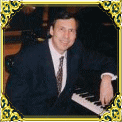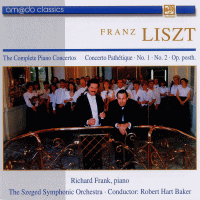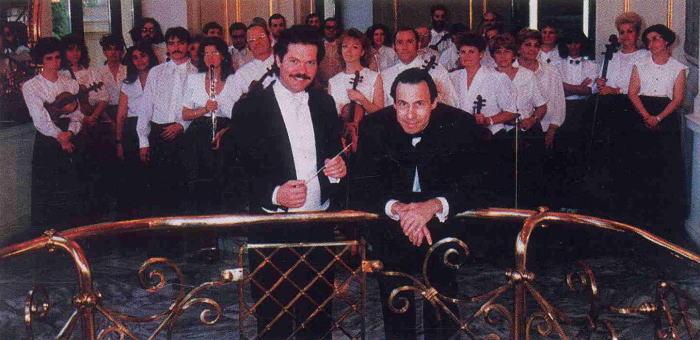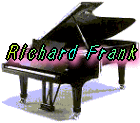|
|
|
|
|
|
|
|
|
|
|
|
|
|
|
|
|
|
|
|
|
|
|
|
|
|
|
|
|
|
|
|
|
|
|
|
|
|
|
|
|
|
|
|
|
|
|
|
|
|
|
|
|
|
|
|
 |
Liszt:The Complete Piano Concertos
Concerto Pathetique,Concerto No.1,Concerto No.2
and Concerto opus posthumous. |
|
|
|
|
|
|
|
|
|
|
|
|
|
|
|
|
|
|
|
|
|
|
|
|
|
|
|
|
|
 |
|
|
|
|
|
|
 |
|
|
|
|
|
|
 |
|
|
|
|
|
|
|
|
|
|
|
|
|
|
|
|
|
|
|
|
|
|
|
|
|
|
|
|
 |
|
Richard Frank,piano
with Robert Hart Baker conducting
the Szeged Symphonic Orchestra
(AU 34050 CD) |
|
|
|
|
|
|
|
|
|
|
|
|
|
|
|
|
|
|
|
|
|
|
|
|
|
|
|
|
|
|
|
|
|
|
|
|
|
|
|
|
|
|
|
|
|
|
|
|
|
|
|
|
|
|
|
|
|
|
|
|
|
|
|
|
|
|
|
|
|
|
|
|
|
|
|
|
|
Concerto Pathétique(G.Darvas) |
19:39 |
|
|
|
|
|
|
|
|
|
|
|
|
|
|
|
|
|
|
|
|
|
|
|
|
|
|
|
|
|
|
|
1. |
Allegro energico-patetico-Agitato-Grandioso |
4:50 |
|
|
|
2. |
Quasi Fantasia-Andante sostenuto |
6:15 |
|
|
|
3. |
Allegro agitato assai-più moderato-piu mosso |
3:28 |
|
|
|
4. |
Andante,quasi Marcia funebre |
4:02 |
|
|
|
5. |
Allegro trionfante |
1:00 |
|
|
|
|
|
|
|
|
|
|
|
|
|
|
|
|
|
|
|
|
|
|
|
|
|
|
|
|
|
|
Piano Concerto No.1 in E flat major |
19:08 |
|
|
|
|
|
|
|
|
|
|
|
|
|
|
|
|
|
|
|
|
|
|
|
|
|
|
|
|
|
|
|
6. |
Allegro maeatoso. Tempo giusto |
5:40 |
|
|
|
7. |
Quasi Adagio |
4:35 |
|
|
|
8. |
Allegretto vivace-Allegro animato |
4:11 |
|
|
|
9. |
Allegro marziale animato |
4:46 |
|
|
|
|
|
|
|
|
|
|
|
|
|
|
|
|
|
|
|
|
|
|
|
|
|
|
|
|
|
|
Piano Concerto No.2 in A major |
21:30 |
|
|
|
|
|
|
|
|
|
|
|
|
|
|
|
|
|
|
|
|
|
|
|
|
|
|
|
|
|
|
|
10. |
Adagio sostenuto assai |
5:20 |
|
|
|
11. |
Allegro agitato assai |
2:00 |
|
|
|
12. |
Allegro moderato |
5:00 |
|
|
|
13. |
Allegro deciso |
3:10 |
|
|
|
14. |
Marziale,un poco meno allegro |
5:50 |
|
|
|
|
|
|
|
|
|
|
|
|
|
|
|
|
|
|
|
|
|
|
|
|
|
|
|
|
|
|
Piano Concerto Op.posthum in E flat |
15:45 |
|
|
|
|
|
|
|
|
|
|
|
|
|
|
|
|
|
|
|
|
|
|
|
|
|
|
|
|
|
|
|
15. |
Andantino-Rezitativo del pianoforte |
2:14 |
|
|
|
16. |
(Allegro)-(Tempo primo) |
3:26 |
|
|
|
17. |
(Andante) |
4:50 |
|
|
|
18. |
(Tempo primo)-(Allegro come prima) |
2:00 |
|
|
|
19. |
Allegro vivace |
3:10 |
|
|
|
|
|
|
|
|
|
|
|
|
|
|
|
|
|
|
|
|
|
|
|
|
|
|
|
|
|
|
total time |
77:25 |
|
|
|
|
|
|
|
|
|
|
|
|
|
|
|
|
|
|
|
|
|
|
|
|
|
|
|
|
|
|
Franz Liszt: The Complete Piano Concertos |
|
|
|
|
|
|
|
|
|
|
|
|
|
|
|
|
|
|
|
|
|
|
|
|
|
|
|
|
|
|
|
In order for the contemporary performer to understand the expanse of Liszt's
creative output, he must venture beyond the familiar to that which is less
well-known, seldom heard, and newly published. The rewards inherent to
such an elaboration of study are obvious to the performer, but they are
no less gratifying to the Liszt enthusiast or casual listener.
Recently, the discovery of two works has expanded the traditional core of Liszt's piano and orchestra repertoire form nine works to eleven. This CD has gathered all the works bearing the title "Concerto", hence the album title "Franz Liszt: The Complete Piano Concertos". The audacious Liszt, forever challenging the proscriptions of post-classical formulae, demonstrates, to a greater or lesser degree, that he does not forsake his allegiance to expanded sonata-allegro forms but further infuses these late Romantic allowances with progressive stretches of musical expression. However, his departures form the traditional piano concerto form demanded justification on the basis of form to legitimize the fulfillment of heretofore unsuspected possibilities. Liszt solved this problem in the Piano Concerto No 1 in E-flat major. Here Liszt created an uninterrupted, seamless, four-movement symphonic structure through the underpinnings of thematic uniformity; with the subsequent Piano Concerto No 2 in A major, this use of thematic cohesion became trademark. Simply stated, at the core of the Lisztian corpus lies a general application of Theme with Variations.
The Concerto opus posthumous (first published in 1989) dates form 1836-39. Its composition was simultaneous with the first sketches of the Concerto Nos 1 & 2, and was long regarded (erroneously) as a discarded sketch of both concertos. Jay Rosenblatt's research of the archives in Nuremberg, Weimar and St. Petersburg brought this third, separate concerto to light. However, Liszt's Concerto Pathetique, an incomplete work (his "Unfinished"), became playable only through the conscientious efforts of Gabor Darvas.Darvas complete the piece in 1952, fastidiously in keeping with the Lisztian aesthetic. This "Grand Solo", begun in 1849 by Liszt, expanded by his pupils, and completed by Darvas more than one hundred years later, has been brought finally to its grand conclusion. |
|
|
|
|
|
|
|
|
|
|
|
|
|
|
|
|
|
|
|
|
|
|
|
|
|
|
|
|
|
|
|
|
|
|
|
|
|
|
|
|
English translation by Barbra Duvall Baker |
|
|
|
|
|
|
|
|
|
|
|
|
|
|
|
|
|
|
|
|
|
|
|
|
|
|
|
|
|
|
 |
|
|
|
|
|
|
|
|
|
|
|
|
|
|
|
|
|
|
|
|
|
|
|
|
|
|
|
|
|
RICHARD FRANK |
|
|
|
|
|
|
|
|
|
|
|
|
|
|
|
|
|
|
|
|
|
|
|
|
|
|
|
|
|
|
|
RICHARD FRANK. Born in Zurich, Switzerland. Studied with Irma Schaichet, a student of Bartok and Busoni, at Zurich Conservatory. Received a teaching certificate in piano SMPV. Passed his artist diploma at the Academy of music in Freiburg, Germany under Professor Edith Picht-Axenfeld. Won the Kiefer Hablutzel Prizes for 1976/77. Studied at the Juilliard School, New York. Master Course with Rudolf Firkusny. Intensive involvement in the work of Franz Liszt led him to found the Franz Liszt Society Switzerland Japan, which has received international acclaim for its innovative concerts. He is presently president of the Society. Herr Frank has given concerts in Europe, the USA and Japan. He is at present on the faculty of the Music Department at Doshisha Women's College in Kyoto and gives masterclasses in Lenk, Switzerland and in Italy at the "Festa Musica pro Mundo Uno". |
|
|
|
|
|
|
|
|
|
|
|
|
|
|
|
|
|
|
|
|
|
|
|
|
|
|
|
|
|
|
ROBERT HART BAKER |
|
|
|
|
|
|
|
|
|
|
|
|
|
|
|
|
|
|
|
|
|
|
|
|
|
|
|
|
|
|
|
Born in New York, ROBERT HART BAKER is a "cum laude" graduate of Harvard University and received his doctorate in orchestral conducting from Yale University.His conducting teachers have included many prominent performers and pedagogues such as Leonard Bernstein Herbert von Karajan and Otto-Werner Mueller. One of the most experienced of young American conductors, Dr.Baker has been conducting at major concert halls troughout the United States since his teen-age years. His professional career began at the age of 17 when he made his debut at Mozart's birthplace, Salzburg, conducting the Mozarteum Orchestra there. Dr.Baker is currently Music Director and Conductor of the Asheville Orchestra, the Saint Louis Philharmonic Orchestra and the York Symphony Orchestra. His many recordings on digital CD include Brahm's Symphonies and the first recording of Ernest Bloch's Symphony in C-Sharp Minor. |
|
|
|
|
|
|
|
|
|
|
|
|
|
|
|
|
|
|
|
|
|
|
|
|
|
|
|
|
|
|
The Szeged Symphonic Orchestra |
|
|
|
|
|
|
|
|
|
|
|
|
|
|
|
|
|
|
|
|
|
|
|
|
|
|
|
|
|
|
|
The Szeged Symphonic Orchestra. Founded in 1969, the Szeged Symphonic Orchestra is an independent institute of art in the city of Szeged. It has two major functions: it accompanies opera productions in the Szeged National Theater, and it gives symphonic concerts organized by National Philharmony or the orchestra itself. The repertoire of the orchestra consists of a wide selection of baroque, classical, romantic and modern music, and has brought success to the orchestra in many countries all over the world.
Viktor Vaszy, the founder and first conductor of the Szeged Symphonic Orchestra
was followed by Tamás Pál and Géza Oberfrank. Since
1991, the artistic activity of the group has been directed by Ervin Acél.
The orthestra has participated in several sound recordings in cooperation
with such publishing companies as Olympia CD (London), Bongiovanni 70
(Italy) and Aurophon (Germany). |
|
|
|
|
|
|
|
|
|
|
|
|
|
|
|
|
|
|
|
|
|
|
|
|
|
|
|
|
|
|
|
 |
|
|
|
|
|
|
|
|
|
|
 |
|
|
|
|
|
|
|
|
|
|
|
|
|
|
|
|
|
|
|
|
|
|
|
|
|
|
|
|
|
|
|
|
|
|
|
|
|
|
|
|
|
|
|
|
|
|
|
|
|
|
|
|
|
|
|
|
|
|